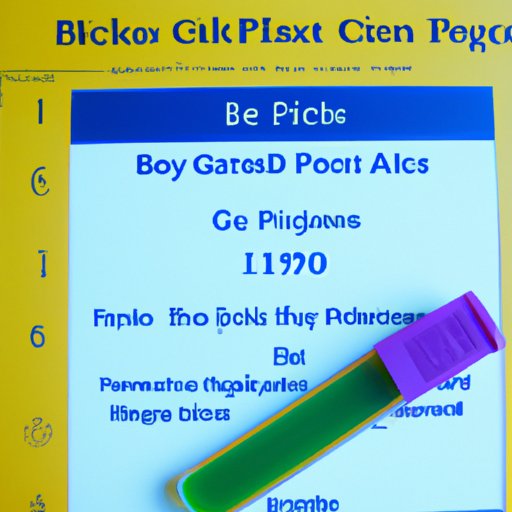Introduction
DNA testing is a powerful tool for understanding our genetic makeup and ancestry. By analyzing a person’s DNA, scientists can learn valuable information about their health, family history and other traits. But when were DNA tests invented? This article will explore the history and development of DNA testing, from its early beginnings to its modern-day applications.

Timeline of the History of DNA Testing
The history of DNA testing begins with the early research and discoveries in the field of genetics. In 1866, Gregor Mendel published his famous paper on the principles of inheritance, laying the foundation for the study of genetics. In 1944, Oswald Avery, Colin MacLeod and Maclyn McCarty identified DNA as the substance responsible for genetic inheritance. Then, in 1953, James Watson and Francis Crick discovered the structure of DNA, paving the way for more advanced genetic technologies.
In the late 1970s and early 1980s, several groundbreaking inventions revolutionized the field of genetics and made it possible to analyze DNA more easily. In 1977, Frederick Sanger developed the first method for sequencing DNA. In 1983, Kary Mullis invented the polymerase chain reaction (PCR), a technique for amplifying small amounts of DNA. And in 1984, Sir Alec Jeffreys made a remarkable discovery: the existence of genetic “fingerprints” that could be used to identify individuals.
These advances in genetic technology made it possible to develop DNA testing methods. In 1989, the first DNA test was developed by British scientists, who used it to identify an accused murderer. Since then, DNA testing has become increasingly sophisticated, and today it is used in a variety of fields, including medicine, forensics and genealogy.

The Pioneers Behind DNA Testing and Their Contributions
Sir Alec Jeffreys is widely regarded as the pioneer of DNA testing. In 1984, while working at the University of Leicester in England, he made a remarkable discovery: the existence of genetic “fingerprints” that could be used to identify individuals. His invention of genetic fingerprinting revolutionized crime scene investigation and allowed law enforcement to match DNA evidence to suspects.
Kary Mullis also played an important role in the development of DNA testing. In 1983, he invented the polymerase chain reaction (PCR), a technique for amplifying small amounts of DNA. PCR is now the most commonly used method for DNA analysis, and it has been instrumental in the development of modern-day genetic testing.
Many other scientists have contributed to the development of DNA testing. These include Walter Gilbert, who developed the first automated DNA sequencing method; Frederick Sanger, who developed the first method for sequencing DNA; and Robert Edwards and Patrick Steptoe, who pioneered the process of in vitro fertilization.

Exploring the Process of DNA Testing
So, how does DNA testing work? The process typically involves collecting a sample of DNA from the person being tested, such as saliva, blood or skin cells. The sample is then analyzed in a laboratory using specialized equipment and techniques, such as PCR or sequencing. The results are then compared to a database of known genetic markers to determine the person’s identity or other traits.
There are several different types of DNA tests available. These include paternity tests, which are used to establish the biological father of a child; forensic tests, which are used to identify a suspect in a criminal investigation; and medical tests, which are used to diagnose genetic diseases and disorders.
DNA Testing: How It’s Used in Criminal Investigations
DNA testing has revolutionized crime scene investigation. Law enforcement officers can now use DNA evidence to match suspects to crimes, even if the suspect has left no other trace of their presence. DNA testing has also been used to exonerate innocent people who were wrongfully convicted, such as those who were wrongly accused of rape or murder.
However, the use of DNA testing in criminal investigations raises ethical concerns. Critics argue that DNA testing can be used to violate a person’s privacy and may lead to false convictions. They also point out that DNA evidence is not infallible and can be contaminated or misinterpreted.
Examining the Impact of DNA Testing on Society
DNA testing has had far-reaching implications for society. It has changed how we view identity, as it can be used to prove or disprove relationships between people. It has also provided valuable insight into our ancestry and medical history, allowing us to understand our genetic makeup and any potential health risks.
DNA testing has also had implications for social justice. For example, it has been used to identify victims of human trafficking, reunite families separated by war or conflict, and provide compensation to victims of medical negligence. On the other hand, it has also been used to deny refugees asylum and to target minority populations.
Finally, there are potential risks associated with DNA testing. These include the misuse of personal data, the risk of discrimination based on genetic information, and the possibility of stigmatizing certain populations.
Conclusion
DNA testing has come a long way since its invention in 1989. Today, it is used in a variety of fields, from criminal investigations to medical diagnostics. Although it has many benefits, it also raises ethical issues and carries potential risks. As DNA testing continues to evolve, it is important to consider the implications of this powerful technology.
(Note: Is this article not meeting your expectations? Do you have knowledge or insights to share? Unlock new opportunities and expand your reach by joining our authors team. Click Registration to join us and share your expertise with our readers.)
